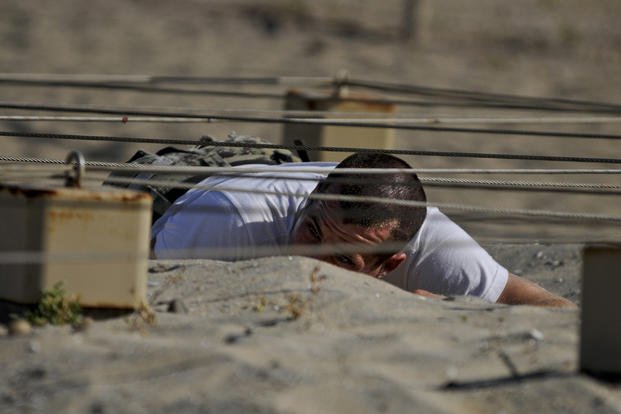Many pre-military and law enforcement recruits preparing for training programs often don't have an obstacle course available before departing. Here is an email from a trainee seeking advice on how to pre-train for this issue:
I do not have access to an o-course, but would really like to be able to train on one, or at least train a workout that has some carryover to something like the BUD/S o-course or the USMC confidence course. Any ideas? Thanks very much.
All obstacle courses have high and low obstacles and usually some distance to run between them. Here is how I recommend training for such a test:
Continue with upper-body strength/endurance workouts
You need the muscles that enable you to perform a pull-up, push-up and dip. Keep doing those in a regular program in your PT workouts. If you are not doing these exercises, here is a sample plan:
Repeat 5-10 times
- Run 100 meters fast
- Push-ups 10-20 reps
- Pull-ups or flexed arm hang 15-20 seconds
- Dips or bench dips 10-20 reps
This type of quick circuit will ensure you are working the right muscles that will help you get over a wall, up a rope and over a fence. Notice the short, fast 100-meter sprint in this workout. This addition will help you cover ground quickly and make up valuable time if you are struggling with any obstacles.
Grip
Climbing a rope or jumping over a wall will require significant upper-body strength, but it also will require you to grip a rope or wall's edge as well.
Flexed arm hangs and pull-ups will help to a degree, but I like to add a piece of rope or rolled towel over a pull-up bar and practice hanging on the two ends or even doing pull-ups with it. That is one of the best grip workouts ever. In fact, during strongman competitions, often they have the world's strongest men hang from a bar as part of the event.
Balance
Because many obstacle courses contain a balance component, find a curb or long beam you can walk or run across to practice. A trick I always use is to run to the end of a balance beam. Do not look straight down, as that can interfere with your ability to stay on the beam.
Weights or calisthenics
Many people ask me what they should use to prepare for military or law enforcement training programs. I always recommend doing a calisthenics-based program, complete with plenty of cardio activity like running, swimming and biking, to increase your endurance and muscle stamina.
I like to supplement the workouts with some weights if you must lift weights, but these programs will not have significant weightlifting in them. This is mainly a logistical issue; large recruit classes are difficult to run through "real" weightlifting programs in a gym.
As a former powerlifter, I understand the urge to lift, but do yourself a favor. While you are pre-training, just PT and run with some weights to balance your training. Put it this way: No 400-pound bench press is going to get you over a wall or up a rope.
Stew Smith is a former Navy SEAL and fitness author certified as a Strength and Conditioning Specialist (CSCS) with the National Strength and Conditioning Association. Visit his Fitness eBook store if you're looking to start a workout program to create a healthy lifestyle. Send your fitness questions to stew@stewsmith.com.
Want to Learn More About Military Life?
Whether you're thinking of joining the military, looking for fitness and basic training tips, or keeping up with military life and benefits, Military.com has you covered. Subscribe to Military.com to have military news, updates and resources delivered directly to your inbox.


















